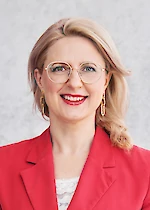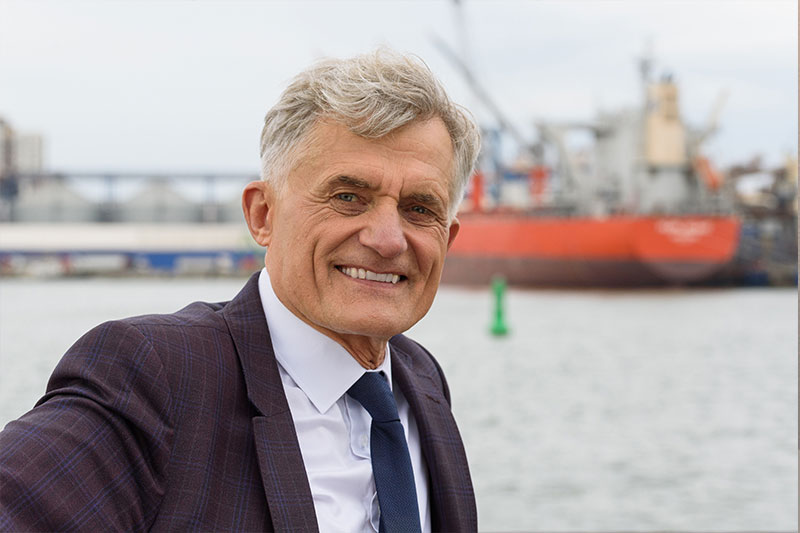Marina Basso Michael
Regional Director Europe
Central Office
+49 40 37709 111
E-Mail

The countries of the Baltic region have remained significant trading partners of the Port of Hamburg – and are growing increasingly important. Germany’s largest universal port currently offers an average of around 35 weekly feeder and short-sea services into the Baltic region, assuming a leading role as transit hub in seaborne foreign trade with countries bordering the Baltic.
Last year Poland took fourth place – 2021: seventh, followed by Sweden – fifth for the third year running and Finland – 2022: sixth, 2021: 13th, 2020: 12th. Growth with Poland was especially strong: at 237,000 TEU, throughput was 24.3 percent up on 2021. Container traffic with Finland developed similarly well, with a 22 percent increase to around 213,000 TEU.
Their trading relations with Russia meant that its assault on the Ukraine posed some challenges for countries on the Baltic, Poland, for instance. “Within a very brief period, existing transport corridors became less significant, and stabilization of the European economy depended on the reaction from logistics companies and the taking into service of new corridors,” reports Krzysztof Kamiński, CEO Of Hamburg- based PKP Cargo Connect.
Until 2022, the internationally operating logistics provider and the German company in PKP CARGO Group mainly looked after intermodal shipments via the New Silk Road. “Owing to the immense changes on the market, the company has partly changed its business profile. It is now responsible for delivering over 200,000 tons of energy raw materials to Poland via German ports,” explained Kamiński, adding that: “For wheat and wheat derivatives from Poland, we have backed shipments to German ports and processing facilities. Specialized wheat cars have enabled us to transport over 40,000 tons of wheat products to terminals in Hamburg, Drentwede and Brake.”
PKP Group expects the European logistics sector to be affected again by geopolitical factors and the war. Logistics companies there need to be flexible and open towards new transport solutions. “Apart from imports of military equipment and fuels, as well as exports in support of Ukraine, we must create stable transport corridors – also covering intermodal traffic – between the EU and Ukraine. These will be fixed elements in Europe’s new logistics architecture,” says Kamiński. The situation will improve on the intermodal rail transport market, especially on the New Silk Road. PKP regards the current downturn in volume as temporary, and is ensuring a constant increase in intermodal cargo in seaports, especially in Hamburg.
Seen purely commercially, Stena Line was able to react flexibly to Russia’s attack on Ukraine, and sees potential in the further growing together of Central and Eastern Europe. Specializing in Ro-Pax ferry services, it was only recently that the Swedish ferry company was able to secure the services of ferry and RoRo terminals in the Port of Ventspils, Latvia. Last year a new and meanwhile established service was opened on the Nynäshman-Hanko route, in Finland. To satisfy the demand for more capacity, Stena Line has deployed modernized, and in some cases lengthened, ferries on the routes Travemünde-Liepaja, Latvia, and Nynäshamn-Ventspils. In 2022 the two brandnew e-flexer ferries ‘Stena Ebba’ and ‘Stena Estrid’ were taken into service on the Karlskrona-Gdynia route, producing higher freight volume and passenger numbers between the continually growing Polish market and Southern Sweden. In addition, for the Rostock-Trelleborg and Travemünde-Liepaja routes, the emphasis is more on freight.
Despite the lack of a ferry link on the River Elbe, there are several reasons why Stena’s head office in Germany is located there. “We opted for Hamburg in 2020 as our commercial centre in Germany, because that it where Germany’s maritime heart beats and the city lies in a favourable location strategically, between our departure ports of Kiel, Rostock and Travemünde,” explains Mikko Juelich, Trade Director Germany and CEO Germany for Stena Line in Hamburg. “In addition, the Stena group has two companies on the spot there with Stena Recycling and Stena Glovis, and with Stena Logistik in Bremen another not far off, with which we shall be stepping up cooperation in the future.”
Freight, as the company’s second mainstay after passengers, has developed well recently: “We were able to further stabilize our freight segment last year, with both accompanied/unaccompanied and project cargo, and also in the intermodal segment“, said Juelich. All the same, “The good 2022 results will benefit us this year, when the costs of the energy crisis hit business. From a good position, we need to be alert.“
| RANK 2022 | RANK 2021 | RANK 2020 | PARTNER COUNTRY | 2021 | 2022 | DIFFERENCE | IN % |
| 4 | 7 | 10 | Poland | 236 | 294 | 56 | 24,3% |
| 5 | 5 | 5 | Sweden | 298 | 292 | –4 | –2,2% |
| 6 | 13 | 12 | Finland | 174 | 213 | 38 | 22,3% |
| 19 | 19 | 19 | Lithuania | 117 | 112 | –5 | 4,4% |
With eight full-container liner services operating weekly in terms of traffic technology, Finland is among the Port of Hamburg’s top partner countries in Baltic container traffic. Among the ports called are Helsinki, Hamina-Kotka, Rauma, Tornio and Oulu. Around 97 percent of Finnish container traffic is handled through Hamina-Kotka, Helsinki and Rauma.
The containerships operated in the Finland trade have capacities of between 850 and 1,900 TEU -standard containers. Depending on the port, traffic direction and rotation, transit time is normally between three and four days. If required, conventional shjipments are transported by a general cargo shipping company’s multi-purpose vessels.
Kimmo Naski, CEO of Finland’s large universal port, is somebody else who underlines how significant the Port of Hamburg is for Hamina-Kotka, where total traffic in 2022 was 11.7 percent up on the previous year. “A large part of our container-feeder transport runs through the Port of Hamburg.” Naski is also optimistic for 2023: Despite strikes for two longer periods this year, growth after January-April totalled 11,4 percent. All the same: “At the moment it doesn’t look as if the Finnish export industry is going with such a swing as at the start of the year.” That makes any forecast to the end of the year difficult.
Here too, repercussions on trade with Russia are naturally strong: “As good as no trade exists between the two countries any longer, reports the CEO. “Of Russian transit traffic via our ports, only fertilizers remain, these belonging in the foodstuffs category. Finnish companies, moreover, previously imported many goods from Russia. “These were transported across the border by train or by truck” Since this no longer possible such goods, especially timber, are now imported from other countries, now arriving in the port by ship.
In addition, Lithuania is an important partner for the Port of Hamburg for maritime and land transport services. There are currently eight container-liner services with Lithuania, all calling the Port of Klaipeda. Containerships with slot capacities of between 870 and 1,400 TEU are deployed. Depending on direction and the number of additional ports served, transit time between Hamburg and Lithuania is between two and four days.

Regional Director Europe
Central Office
+49 40 37709 111
E-Mail
What is your first thought when you consider the relationship between the Ports of Klaipèda and Hamburg?
That as between all ports there are a few differences, but they have many things in common. To start with, nearly all ports are trimodal. Lithuania and Germany are also closely interwoven commercially: Around twelve percent of our total cargo comes from Germany. And our mentality is similar. Hamburg could become our best friend.
What does the HHM membership sealed in May mean for you?
The aim is not only cooperation, but also illustrates that Klaipèda is looking for strong partners and not simply remaining in its own bubble. The two ports can do more than simply exchange data, experience, analyses and statistics, but also mutually promote each other commercially. We are very happy that Port of Hamburg Marketing has accepted us as a member, and that’s partly due to the good way we have developed.
How has freight throughput developed?
We finished last year with freight volume of 36.1 million tons and were able to assert our fourth place among the ports of the Eastern area of the Baltic. Total freight was 21 percent lower than 45.6 million tons in 2021. That was due to the loss of almost all transit cargo due to sanctions against Belarus and the war in Ukraine. However, the result is better than originally forecast.

Which cargoes are affected by the war and sanctions?
The downturn is primarily in transit freight, which is down by 35 percent. That the total is only 21 percent lower shows that we have been able to compensate for part of the volume. The main produce no longer being loaded was white Russian fertilizer as a bulk cargo. This was at least partly offset by a record number of containers and an increase of LNG and other oil product shipments. The Port of Klaipėda has confirmed its position on the East coast of the Baltic and with 57 percent increase and more than one million TEU is now the leader for handling containerized freight. Another reason for this is that as a new hub, we are called by MSC in the main services to and from Asia, Pakistan and India, along with North and South America, and operate feeder services in the Baltic countries for this leading shipping company.
In view of the war and the challenging geopolitical situation, what strategy are you pursuing?
For us one thing is clear: We face West. In addition, we need to create additional value for the ports over and above cargo throughput. The aim is to compensate for cargo losses - namely 40 percent less transhipment cargo since the start of the war in February 2022.
Are there already firm steps towards this?
Lithuania has just invited tenders for offshore wind energy plants with 700 megawatts. Additional ones for an extra 700 megawatts will follow in the autumn. That means that we are in process of expanding our infrastructure so that we can operate as an installations and base port. Water power is a further exciting area. During a visit to Hamburg, I saw some of Hamburg Port Authority’s hydrogen powered vehicles, which I found most exciting.
What are your expectations for 2023?
How we develop depends greatly on the sanctions packages, which we unreservedly support. We are therefore busying ourselves with compensation through other categories of goods. With three million tons, in the first quarter of this year we handled twelve percent less cargo compared to last year. For the year, I reckon with 35 million tons. On container handling, we want to retain one million TEU. What helps us there is that as a universal port, we are positioned very diversely and from bulk to RoRo and liquid cargoes and to containers, we handle virtually everything, even passengers. It is hard for me to say what we do not handle, except hazardous goods and biological freight.